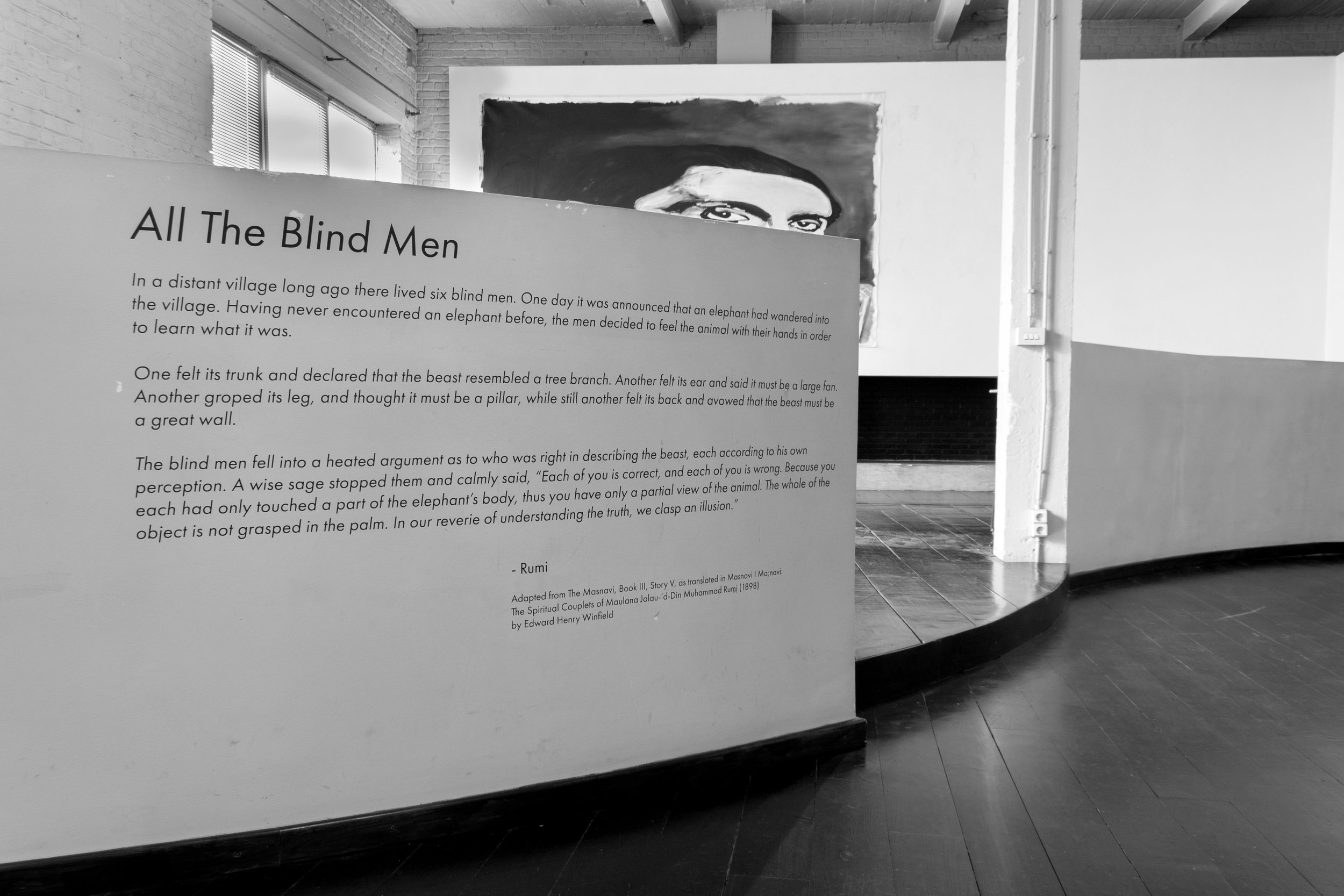
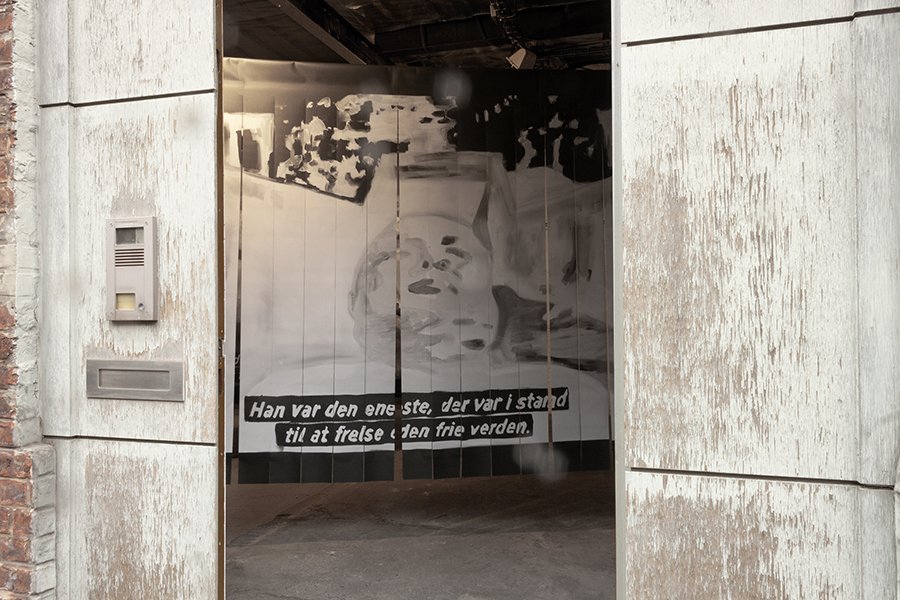
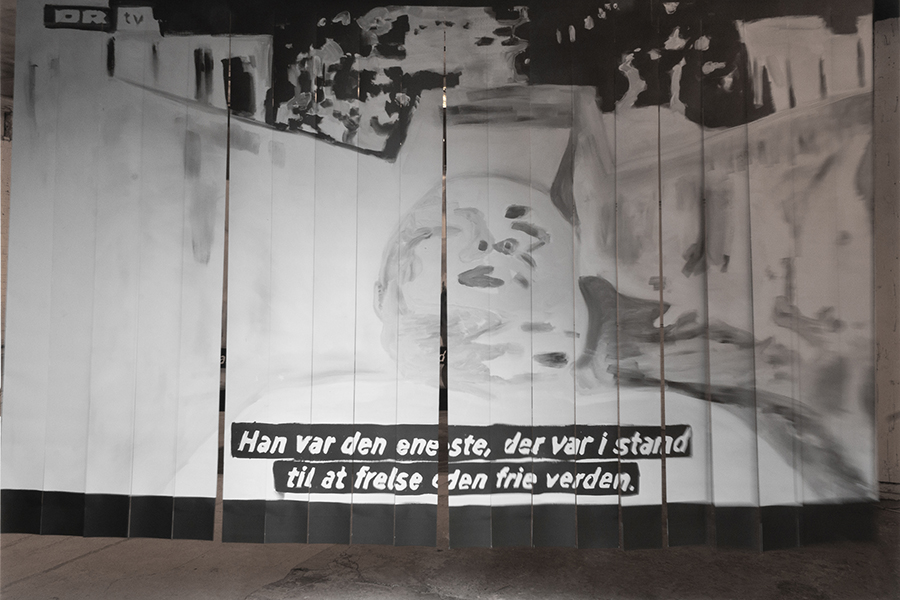
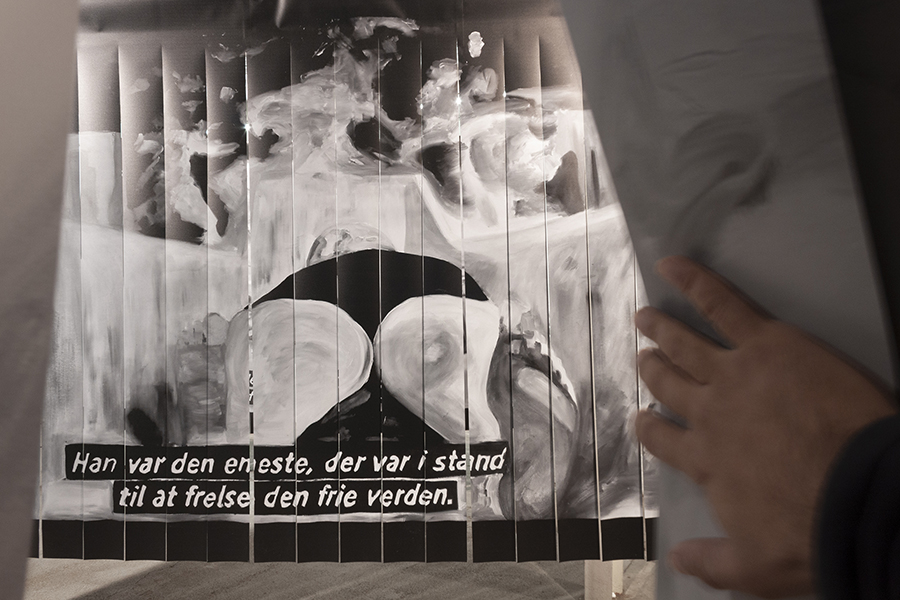
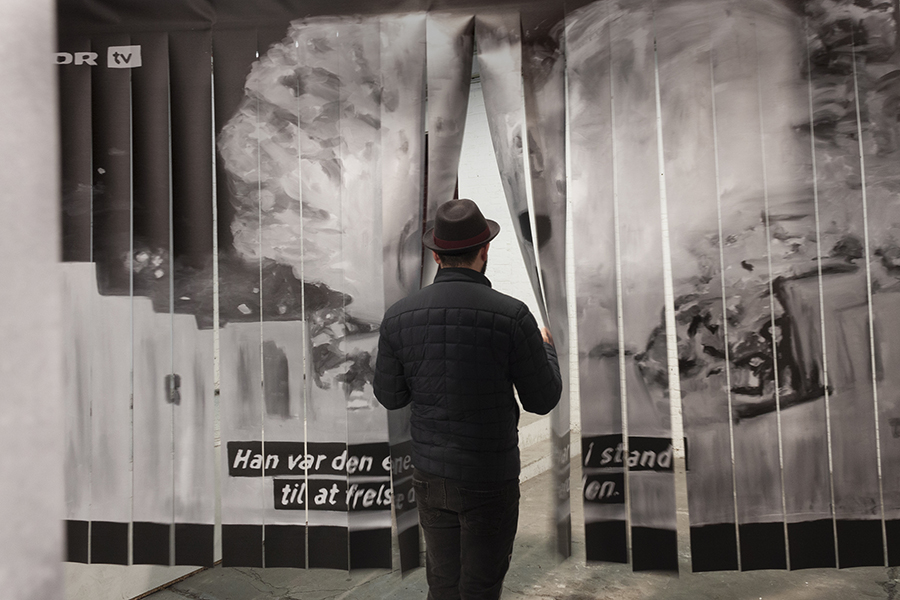
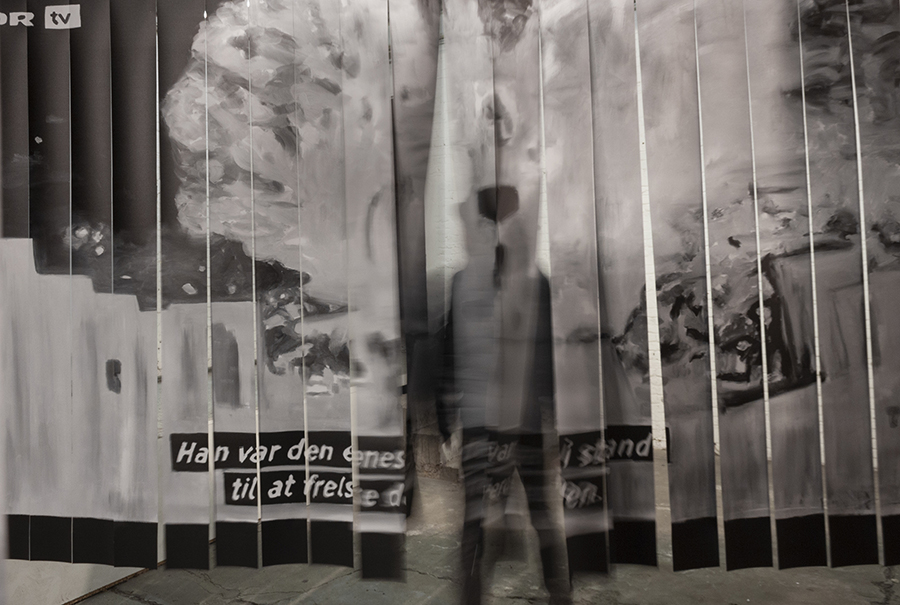
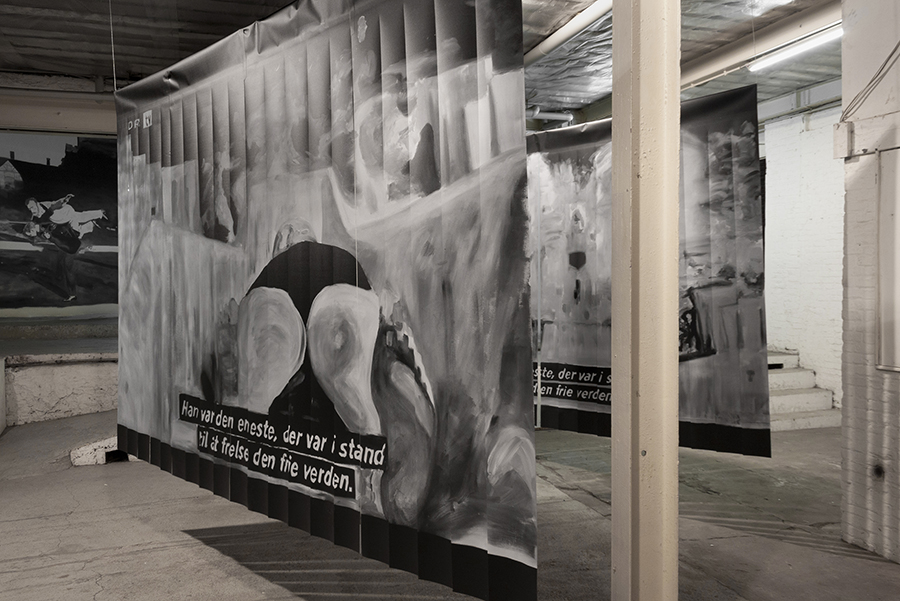
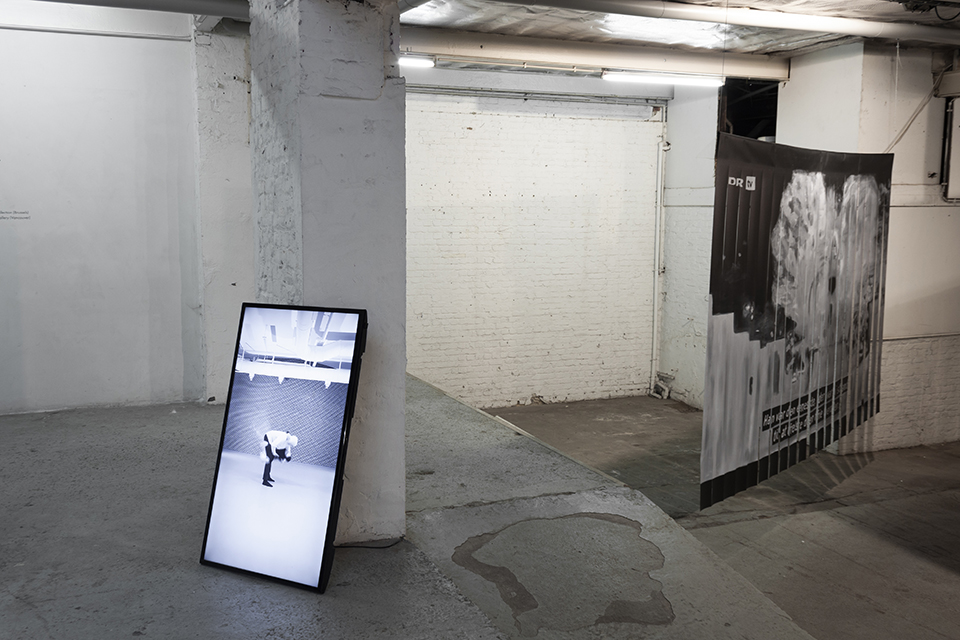



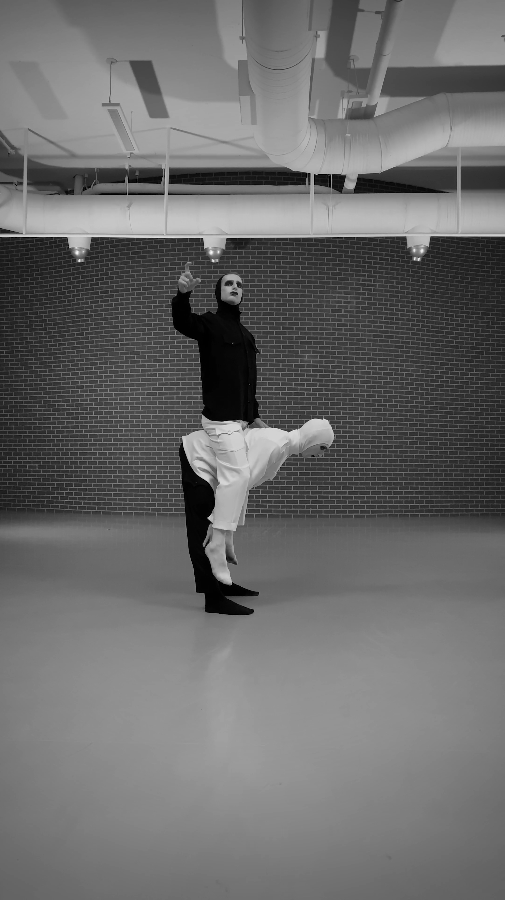
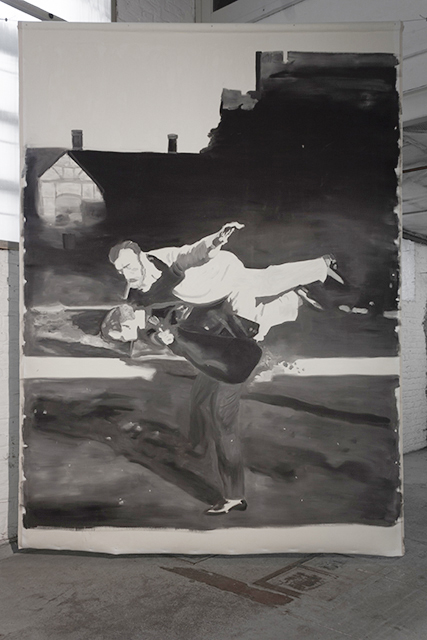








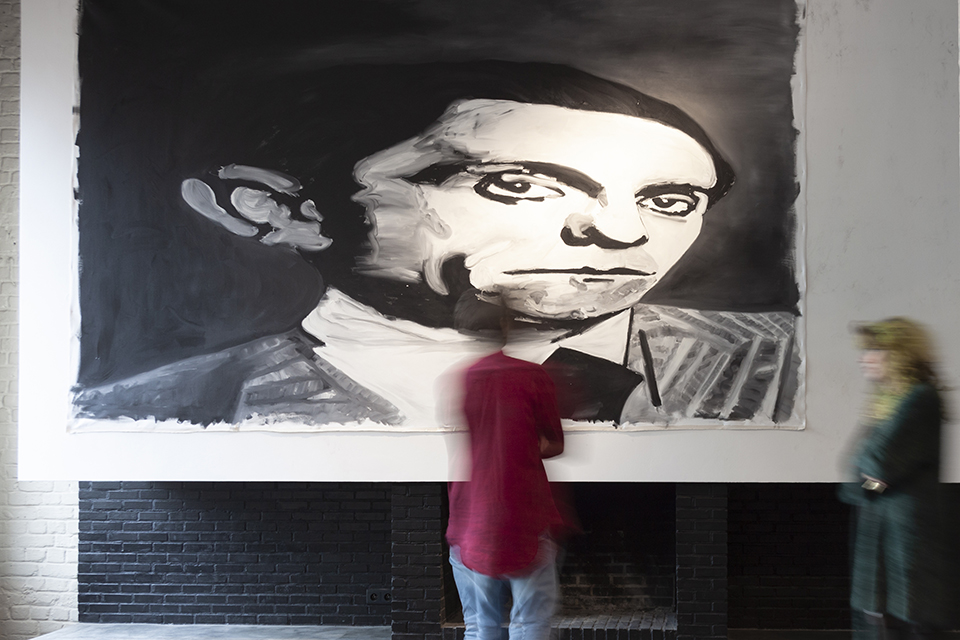







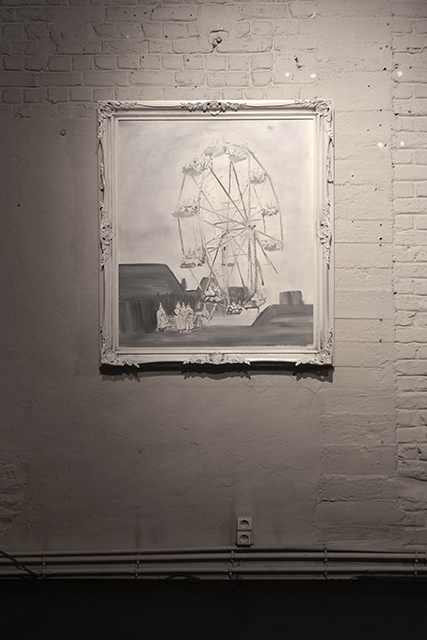



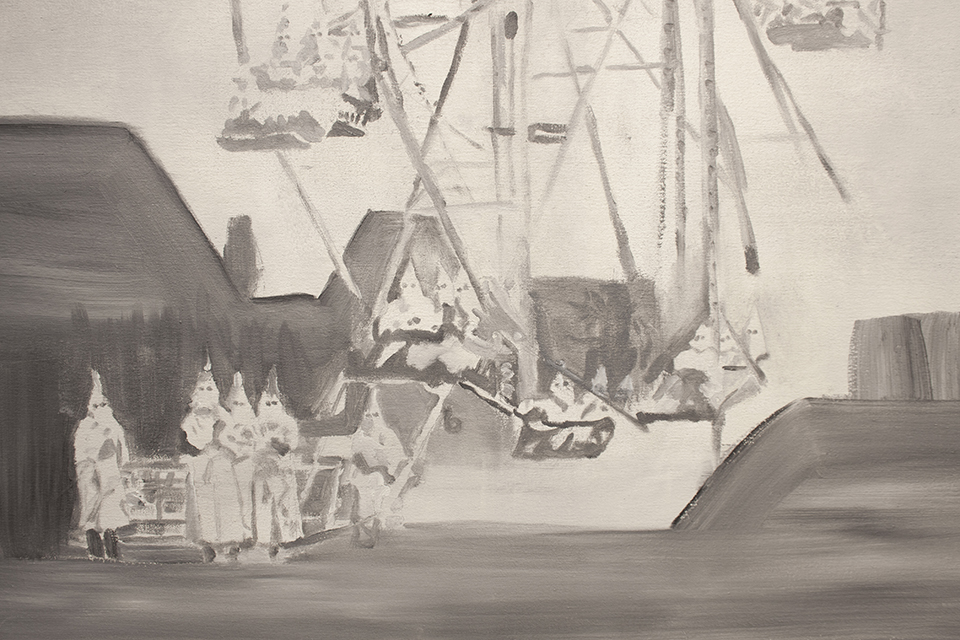

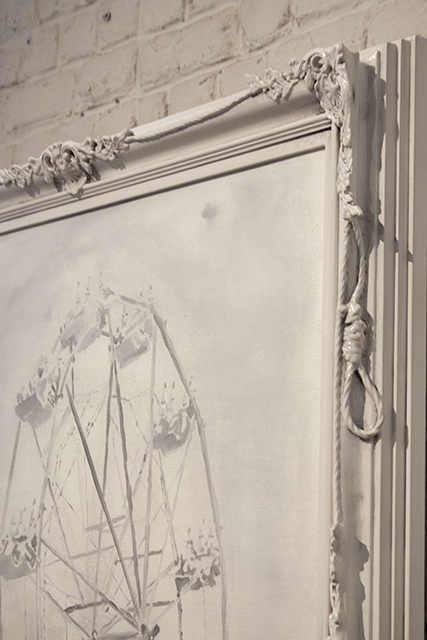

All the blind men presents the results of Babak Golkar’s two-year long investigation into the possibilities of painting: the apparatus of its circulation and its tenacity as a means to carry meaning and value. The subjects of these representational works draw upon key historical characters and political moments from the last 100 years, each of which continues to resonate with uncomfortable potency in our current political moment. Manifesting in an array of media and object forms, they demonstrate the artist’s signature working process of deconstruction, replication and transformation.
Golkar’s research emerges from his interest in the relationship between space and human conditions in the contemporary world, and aims to both examine and upend established ways of looking. The exhibition’s title references an ancient parable about a group of sightless men who come to blows after each attempting to describe an elephant based on the part of the animal’s body, they are able to touch. Elements of this story, which warns about the limitations of perception, the danger of misinformation and the folly of claiming absolute truths, surface throughout the exhibition, in both form and content: the image of Chairman Mao swimming (or is it perhaps his body double?) appears in multitude in a wallpaper design that is itself multiplied on the surface of a field of mirrored ceramics; the Third Reich’s Minister of Propaganda confronts visitors in a monumental, anamorphic painting; and Brecht’s sobering stage-play Mann Ist Mann is conjured through a triangular dialogue between sound, video-recorded performance, and a painted image of the Tsar of Russia pretending to fly. In each case, by distorting assumed certainties of perspective, Golkar questions accepted cultural and socio-economic systems and ideological viewpoints—as well as their persistence over time.
All the blind men has been organized by the Contemporary Art Gallery, Vancouver, in partnership with the Servais Family Collection, and presented at their collection space The Loft in Brussels.

Inkjet on vinyl
120 x 84 inches
“If you are going through hell, keep going. Churchill” is a triptych, printed on commercial vinyl, depicting images of three large scale paintings. The subjects of these paintings are from three video stills from a French documentary on Winston Churchill. In the sequence, Churchill is shown vacationing in south of France, going down a water slide, head first and face up. He hits the water and his swim trunk comes off and floats on the water. Much like the style of an entry point to a meat packing warehouse, these vinyl prints are cut in strips to create a pathway.
There are a few points of inquires this work is attempting to investigate. Why would Churchill, who was very much aware of the power of his own image and its impact on public and posterity, set up this documentation knowing that he is portrayed very casually? Since film cameras were not readily available and were not small devices around the time that the film was made, it makes it all the more intentional to set up the large camera with at least two persons behind it controlling the frame. It makes one wonder if the idea of play is at the core of this piece of subtle propaganda. In addition, the documentary was shown in DRTV, a Danish channel, with a Danish subtitle that reads: “he was the only man who was able to save the free world”, creating another irony with the images behind it.
The title of the installation, “If you are going through hell, keep going. Churchill” is from a popular meme going around the internet that shows an image of Churchill with the usual pose, much like an old school principal, one hand on his waste and the other hand holding a cane, one eyebrow slightly raised and no smile. Another level of irony is raised when one realizes the quote is not from him. The Churchill institute insists that, though the quote might sound like something Churchill would say, there’s no recorded evidence of it anywhere.

2017-2019
HD video
6' 30"
Mann Ist Mann is an installation with two components: 1) a large drape-like lead-based oil painting 2) an HD video on a monitor.
The painting is of a photograph taken of Nikolay II, Tsar of Russia pretending to fly on the back of his friend and cousin (Prince Nicholas of Greece) in 1899. While the two powerful men are captured in the image being playful, at a subterranean level the image is used in the painting as a trope, referencing another powerful and playful duo: Vladimir Putin and Vladislav Surkov. Surkov, a theatre major turned politician, has served as both an official and unofficial advisor to the Kremlin for over a decade. He is known for systematically introducing theatrical methods (specifically Brechtian epic theatre) to contemporary local and global politics, applying them cynically and in skewed ways.
The video is a recording of a five sessions rehearsal with two contemporary dancers. This piece is an interpretation of a piece of music that Bertolt Brecht wrote for an early play, titled Mann Ist Mann, which he played between 1924-1926. This tragicomedy is set in an imaginary city in India and starts with a dolt Irish man who goes to the market to buy a fish but instead he gets convinced by the shopkeeper to buy a cucumber he doesn’t need. When three soldiers from the British regiment witness this, they approach him and ask him to pretend to be a missing soldier from their cadette in exchange for a bargain priced elephant. He agrees and there begins his life as a double identity as a soldier. The play humorously explores themes of war, human fungibility, and identity. One of the agitprop works inspired by the developments in USSR praising the Bolshevik collectivism and replaceability of each member of the collective: a man is a man.

December 5, 2017
Lead-based oil on wooden panel
16 x 20 inches each
Deaf Feet (December 1-31, 2017) concludes the one year of painting (Dec. 2016- Dec. 2017). Each panel is painted each day in December of 2017 from the 1st to the 31st. All are of the same image, an upside down elephant. They are painted upside-down and exhibited in the same orientation, in a row and on the floor, leaning against the wall.

December 1-31, 2017
31 wooden panels painted with lead-based oil paint
16 x 20 inches each

December 1-31, 2017
31 wooden panels painted with lead-based oil paint
16 x 20 inches each

2017
Lead oil on canvas
136 x 84 inches
MP3 sound
47" seconds
Sellers (Goebbels) is an installation with a large-scale painting and a sound piece. Sellers (Goebbels) traces the connections between propaganda and marketing, through the works of the American propagandist and public relations mogul Edward Bernays and the minister of information and propaganda of the Third Reich, Joseph Goebbels.
The sound piece is a 20 seconds clip featuring the voice of a woman (German female celebrity pilot Thea Rasche) from the 1920’s. She is advocating young women to express themselves through their clothes. In the first pass, the clip might come across as an early feminist advocation through the rhetoric of freedom and self-expression, however, further investigation makes clear that she was employed and scripted by Bernays. Bernays was hired by his client, William Hearst, a fashion magazine owner to advertise for it. What is significant about Bernays is his careful research-based theatrical and well-orchestrated advertising campaigns that relied so much on studies of the human subconscious done by his uncle, Sigmund Freud.
The painting is a portrait of Joseph Goebbels. Anamorphic technique is used in this painting to skew his portrait, creating a dynamic perspective with the viewer that changes based on physical positioning. From different angles each viewer will perceive the image differently.
In 1928 Bernays wrote a book entitled “Propaganda”, which–not coincidentally–ended up on Goebbels’ desk and he repeatedly referred to the book as a resource for his own propaganda for war.

2017-2019
Silver-infused porcelain hand crafted in China
20 (h) x 8 (d) inches
inkjet print on vinyl
104 (l) x 54 (w) inches
In the summer of 1966 Mao, the 72-year-old Chairman of the Chinese Communist Party, grappled with criticism and controversy, took a dip in the Yangtze River to show the world that he was still in robust health and very much in control and power. It was a propaganda coup. It is the first of its kind but many politicians have repeated the method since, think of Putin riding a horse in the wild topless.
The image of Mao swimming in the river with his bodyguards circulated in the media and BBC reported it from their station in China. This image from the BBC archives is the subject of the painting Drifters. However, the audience would never see this painting as it has been transformed into a tiled and collaged image and printed onto a vinyl table cover, much like the ones sold for an outdoor picnic table.
This vinyl was printed in china alongside 10 pieces of porcelain that are covered with silver. These piece of porcelain which sit on top of the table cover are set in a row and resemble empty artillery shells, but instead of rough and cold texture of a metal shell, these objects warmly, but anamorphically, reflect their surrounding–including the image of Mao.

2017-2019
Silver-infused porcelain hand crafted in China
20 (h) x 8 (d) inches
inkjet print on vinyl
104 (l) x 54 (w) inches

2017-2019
Silver-infused porcelain hand crafted in China
20 (h) x 8 (d) inches
inkjet print on vinyl
104 (l) x 54 (w) inches

2017-2019
Silver-infused porcelain hand crafted in China
20 (h) x 8 (d) inches
inkjet print on vinyl
104 (l) x 54 (w) inches

2017-2019
Silver-infused porcelain hand crafted in China
20 (h) x 8 (d) inches
inkjet print on vinyl
104 (l) x 54 (w) inches

2017-2019
Silver-infused porcelain hand crafted in China
20 (h) x 8 (d) inches
inkjet print on vinyl
104 (l) x 54 (w) inches

2017-2019
Silver-infused porcelain hand crafted in China
20 (h) x 8 (d) inches
inkjet print on vinyl
104 (l) x 54 (w) inches

2017-2019
Lead-base oil paint on canvas, custom-made wooden frame
40 x 46 x 4 inches
From a distance, the painting–done in a washed-out and faint impressionist style–depicts a Ferris wheel in an amusement park and the frame innocently resembles an ornate French frame. On a closer look the subject comes to light more: the seats of the Ferris wheel are filled with hooded figures belonging to the KKK as well as some embers posing for the camera on the ground. The image is from a photograph taken in Colorado in 1924 of the KKK amusement park. To complement the painting the ornate frame mimics the old colonial style of frames with an addition: a miniature sized noose is added to either sides of the frame.

2017-2019
Lead-base oil paint on canvas, custom-made wooden frame
40 x 46 x 4 inches

2017-2019
Lead-base oil paint on canvas, custom-made wooden frame
40 x 46 x 4 inches

2017-2019
Lead-base oil paint on canvas, custom-made wooden frame
40 x 46 x 4 inches
